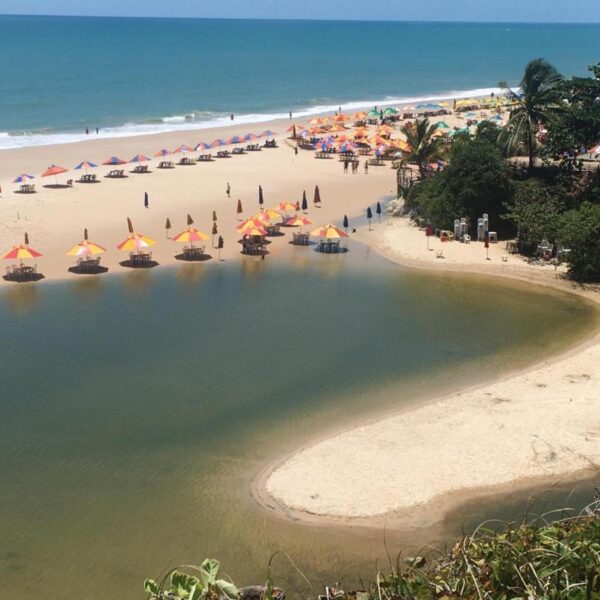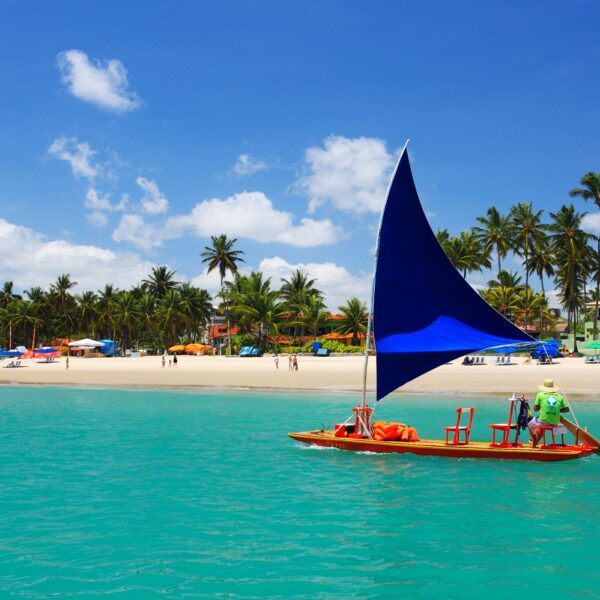The beaches along the 187 kilometers of the Pernambuco coastline are already quite frequented by tourists, but, far from the coast, there is a lesser-known way to refresh the body in dives throughout the year: the waterfalls. The Mata Sul Territory – PE covers an area of 4,003.40 Km² and […]
Paraíba
Paraíba has one of the most beautiful coastlines such as Baía da Traição, Barra de Mamanguape and Cabedelo, as well as the architectural monuments of João Pessoa, the Archaeological Site of Ingá and Cabaceiras.
Paraíba, the place in the Americas where the sun rises first. This is where Ponta de Seixas is located, the most easterly place on the entire South American continent.
Its capital, João Pessoa, has more than 425 years of history, whose origins date back to 1585. It is the third oldest city in Brazil and despite being a capital, João Pessoa is still a quiet town.
Situated 120 kilometres north of Recife and 180 kilometres south of Natal, João Pessoa is full of parks, avenues and ornamental and fruit trees and even has one of the largest reserves of Atlantic forest in an urban area. The reserve, known as the Botanical Garden, covers an area of 515 hectares. Seen from above it looks like a huge green heart in the middle of the city. That’s why João Pessoa is the most wooded city in all of America and the second in the world, only behind Paris.
The coastline of Paraíba, 117 kilometres long, has spectacular exotic beaches with tropical waters showing a cinematographic set where the main actors are nature and tranquillity. On the coast of Paraíba you can also find cliffs, dunes, rivers and forests, you can practise various activities in full contact with nature.
The south coast of Paraíba has a breathtaking landscape, with beautiful almost deserted beaches, highlighting Coqueirinho, Carapibus, Tabatinga, Barra de Gramame and the seductive beach of Tambaba that attracts visitors from all over the world for having the only official nudist camp in all of Northeast Brazil.
The north coast of Paraíba is equally fascinating. From Barra de Camaratuba beach to Intermares, we find not only wild-looking beaches but also historic buildings. Here you’ll find the Fortaleza de Santa Catarina in the port city of Cabedelo, recognised as one of the most important military monuments of Portuguese colonisation. Further north, on the Mamanguape river bar, you’ll find the Marine Manatee Preservation Project. Here these animals are rehabilitated to return to their natural habitat. Baia da Traição is home to the Potiguaras Indigenous Reserve. An indigenous people who still preserve their ancestral traditions.
The interior of the state of Paraíba offers visitors various eco-tourism activities. Among them, enjoy hiking through a landscape where extensions of sugarcane cultivation cohabit with forest, underground caves, thermal waters and crystal-clear waterfalls. Towns such as Campina Grande, where the largest São João in the world is celebrated, Bananeiras and Alagoa Grande stand out, with colonial-style buildings and artisanal distilleries of Brazil’s best-known spirit “Cachaça!”.
As we move further into the interior of Paraíba, the climate becomes drier and the landscape changes dramatically. This region known as O Sertão, is prone to long periods of drought. Here we find giant stones of particular shapes as in “Lajedo de Pai Mateus”, cave paintings of ancient indigenous peoples and important traces of ancient dinosaur footprints of incredible archaeological value.
History of the Centro Cultural São Francisco in João Pessoa, Paraíba, Brazil
The Centro Cultural São Francisco is located in the historic centre of João Pessoa in Paraíba. The Centro Cultural São Francisco is formed by a magnificent architectural complex that includes: Church of São Francisco Convento de Santo Antônio Chapel of the Third Order of São Francisco Chapel of São Benedito […]
Sugar mills around Porto de Galinhas in Pernambuco
The sugar mills in the vicinity of Porto de Galinhas PE date back to the time of colonial Brazil. The historical origin and the social and economic development of the state of Pernambuco are strongly linked to the sugar agro-industry, which, after four centuries of apogee, left as a legacy […]
Splendour of geoforms at Lajedo de Pai Mateus in Paraíba, Brazil
The Lajedo de Pai Mateus is an archaeological site that has a rocky elevation of 1.5 km², with numerous other stone blocks. It stands out for its beauty, and attracts tourists from various parts of the country. In the northern northeast of Brazil, in the sectors where there is an outcropping crystalline […]
Areia is home to the first mills in Paraíba and has a lot of history
Nicknamed the “Princess of Brejo”, Areia prides itself on rarely exceeding 25 degrees in a Paraíba in full drought. In the winter, thermometers easily go below 10 degrees. In the Paraíba town of Areia, this experience is accompanied by visits to mills, visits to museums and the opportunity to embark […]
Tourist attractions in the municipality of Mataraca PB
Those who visit the municipality of Mataraca should not miss the Bom Jesus Mother Church, take a walk along the Camaratuba River, take a bath in Lagoa Encantada (a crystal clear water mirror surrounded by mangabeiras), Barra de Camaratuba Beach and visit the Uçá Crab Ecological Park. One of the […]
Baía da Traição has beautiful beaches, a route rich in historical curiosities
Baía da Traição is a municipality located approximately 90 km from the capital, João Pessoa, on the north coast of Paraíba. The municipality extends over 102.4 km² and had 8,993 inhabitants in the last census. The demographic density is 87.8 inhabitants per km² in the territory of the municipality. Neighbouring […]
Pitimbu in Paraíba has a setting rich in natural pools, estuaries and cliffs
Pitimbu is a municipality in the state of Paraíba, located in the micro-region of the South Coast and metropolitan region of João Pessoa; The state of Paraíba has increasingly surprised tourists with beautiful beaches, such as Pitimbu, which has been a destination for the summer. The place is occupied by […]
History of the Foundation of Paraíba and João Pessoa
Before Cabral’s arrival in Brazil, the coast of Paraíba was populated by the Tabajaras and Potiguaras Indians. But effective colonisation began in 1581, during the Iberian Union, with a settlement on Camboa Island, on one bank of the Paraíba River, which was destroyed by French pirates. At that time, the […]
The oldest churches in Pernambuco and the first church in Brazil
More than just expressions of faith, Pernambuco’s churches have kept traces of our history and culture since the 16th century. The oldest religious buildings in Pernambuco date back to the 16th century. They were built between 1526 and 1580. The first Brazilian church, located on Itamaracá Island, is the Church […]
Tourist attractions of Gravatá in Agreste Pernambucano
Gravatá in the interior of Pernambuco located 80 km from Recife, on the BR-232 motorway that connects Recife to Caruaru, with an altitude of 447 m above sea level and with a pleasant climate, average temperature of 16 degrees, Gravatá has as its strong point the secular architecture of the […]
Best beaches in João Pessoa, south and north coast of Paraíba
With fine white sand beaches, warm and crystal clear waters, paradisiacal landscapes and mouth-watering gastronomy, the Paraiba coastline has been attracting tourists. Paraíba is known for its tropical coastline and Portuguese colonial architecture. The capital, João Pessoa, has beaches such as Manaíra and Tambaú, as well as coral-filled dive sites […]
Porto de Galinhas Beaches in Pernambuco – Tourism Guide
Porto de Galinhas, in the south coast of Pernambuco, is within the municipality of Ipojuca is the beach of Porto de Galinhas which, for 10 years, has been considered the best beach in Brazil. The beach is inside a charming village with many shops, restaurants and cafes. Just 43 km […]
Best beaches in Fernando de Noronha and the Pernambuco coastline
Pernambuco is one of the most exuberant and expressive states of the Northeast, not only because of the beauty of its beaches, as you may have noticed, but also because of its strong culture. The colonization of Europeans created some cultural marks that can be seen in the cuisine, architecture […]
Porto de Galinhas gathers natural pools and crystal clear waters
The balneário Porto de Galinhas is part of the Costa dos Corais and is located in the south coast of Pernambuco, in the municipality of Ipujoca, about 40 minutes from Recife. It is one of the main beach destinations in northeastern Brazil. Access to Porto de Galinhas is via the […]
Araruna and the Pedra da Boca State Park – Tourism Guide
Araruna is a Brazilian Municipality in the State of Paraíba, being included in the mesoregion of Agreste Paraibano, in the microregion of Curimataú Oriental (formed by Araruna, Cacimba de Dentro, Solânea, Dona Inês, Tacima, Casserengue and Riachão). Nature, history, events, gastronomy, handicrafts and culture are present practically everywhere in the […]



































